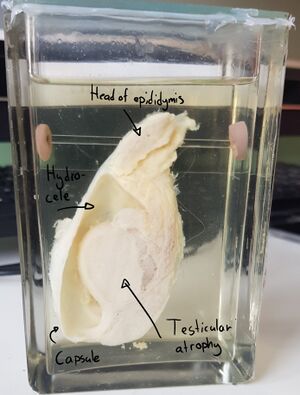45. Chronic epididymitis. Hydrokele. Atrophia of the testes.: Difference between revisions
(Created page with "'''Organ''': Epididymis, testis '''Description''': The testis is atrophied. There is fluid between the parietal and visceral layers of the tunica vaginalis, called hydrocele. The epididymis is inflamed, showing small greyish discolorations. '''Diagnosis''': Chronic epididymitis, testicular atrophy and hydrocele '''Causes''': * Chronic epididymitis ** STDs ** Tuberculosis ** Sarcoidosis * Testicular atrophy ** Atherosclerotic ischaemia ** Recurrent trauma ** Cirrhosi...") |
mNo edit summary |
||
| Line 1: | Line 1: | ||
''This prep is no longer part of the patho 2 topic list.'' | |||
'''Organ''': Epididymis, testis | '''Organ''': Epididymis, testis | ||
Revision as of 16:54, 22 May 2022
This prep is no longer part of the patho 2 topic list.
Organ: Epididymis, testis
Description:
The testis is atrophied. There is fluid between the parietal and visceral layers of the tunica vaginalis, called hydrocele. The epididymis is inflamed, showing small greyish discolorations.
Diagnosis: Chronic epididymitis, testicular atrophy and hydrocele
Causes:
- Chronic epididymitis
- STDs
- Tuberculosis
- Sarcoidosis
- Testicular atrophy
- Atherosclerotic ischaemia
- Recurrent trauma
- Cirrhosis
- Anabolic steroid abuse
- Recurring inflammation
- Hydrocele
- Inflammation
- Heart failure
- Cirrhosis
- Trauma
- Torsion
Theory:
While small greyish discolorations are typically characteristic for chronic epididymitis these discolorations are not really visible on this preparation due to the formalin.

